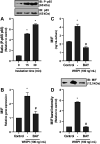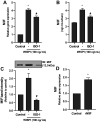WISP1 induces the expression of macrophage migration inhibitory factor in human lung fibroblasts through Src kinases and EGFR-activated signaling pathways
- PMID: 38145300
- PMCID: PMC11193488
- DOI: 10.1152/ajpcell.00410.2023
WISP1 induces the expression of macrophage migration inhibitory factor in human lung fibroblasts through Src kinases and EGFR-activated signaling pathways
Abstract
Wnt1-inducible signaling protein 1 (WISP1/CCN4) is a secreted matricellular protein that is implicated in lung and airway remodeling. The macrophage migration inhibitory factor (MIF) is a pleiotropic cytokine that has been associated with chronic lung diseases. In this study, we aimed to investigate the WISP1 signaling pathway and its ability to induce the expression of MIF in primary cultures of fibroblasts from normal human lungs (HLFs). Our results showed that WISP1 significantly stimulated the expression of MIF in a concentration- and time-dependent fashion. In WISP1-induced expression of MIF, αvβ5-integrin and chondroitin sulfate proteoglycans as well as Src tyrosine kinases, MAP kinases, phosphatidylinositol 3-kinase/Akt, PKC, and NF-κB were involved. WISP1-induced expression of MIF was attenuated in the presence of the Src kinase inhibitor PP2 or the MIF tautomerase activity inhibitor ISO-1. Moreover, WISP1 significantly increased the phosphorylation and activation of EGF receptor (EGFR) through transactivation by Src kinases. WISP1 also induced the expression of MIF receptor CD74 and coreceptor CD44, through which MIF exerts its effects on HLFs. In addition, it was found that MIF induced its own expression, as well as its receptors CD74/CD44, acting in an autocrine manner. Finally, WISP1-induced MIF promoted the expression of cyclooxygenase 2, prostaglandin E2, IL-6, and matrix metalloproteinase-2 demonstrating the regulatory role of WISP1-MIF axis in lung inflammation and remodeling involving mainly integrin αvβ5, Src kinases, PKC, NF-κB, and EGFR. The specific signaling pathways involved in WISP1-induced expression of MIF may prove to be excellent candidates for novel targets to control inflammation in chronic lung diseases.NEW & NOTEWORTHY The present study demonstrates for the first time that Wnt1-inducible signaling protein 1 (WISP1) regulates migration inhibitory factor (MIF) expression and activity and identifies the main signaling pathways involved. The newly discovered WISP1-MIF axis may drive lung inflammation and could result in the design of novel targeted therapies in inflammatory lung diseases.
Keywords: EGFR; MIF; Src kinases; WISP1/CCN4; lung inflammation.
Conflict of interest statement
No conflicts of interest, financial or otherwise, are declared by the authors.
Figures














References
-
- Perbal B, Tweedie S, Bruford E. The official unified nomenclature adopted by the HGNC calls for the use of the acronyms, CCN1-6, and discontinuation in the use of CYR61, CTGF, NOV and WISP 1-3 respectively. J Cell Commun Signal 12: 625–629, 2018. [Erratum in J Cell Commun Signal 13: 435, 2019]. doi:10.1007/s12079-018-0491-1. - DOI - PMC - PubMed
Publication types
MeSH terms
Substances
LinkOut - more resources
Full Text Sources
Medical
Molecular Biology Databases
Research Materials
Miscellaneous

